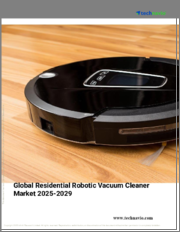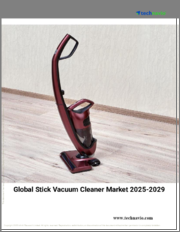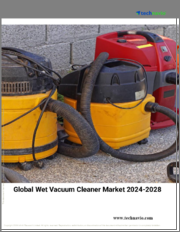
|
시장보고서
상품코드
1623387
세계의 습식 및 건식 청소기 시장 규모 : 유형별, 용도별, 지역별, 범위 및 예측Global Wet and Dry Vacuum Cleaners Market Size By Type(single phase-type, three phase-type), By Application(food industry, healthcare industry), By Geographic Scope And Forecast |
||||||
습식·건식 청소기 시장 규모와 예측
습식·건식 청소기 시장 규모는 2024년에 138억 달러로 평가되며, 2024-2031년 CAGR 6.7%로 성장하며, 2031년에는 342억 3,000만 달러에 달할 것으로 예측됩니다. 습식 및 건식 진공 청소기 사용의 장점에 대한 인식이 높아짐에 따라 전 세계 여러 지역에서 습식 및 건식 진공 청소기 사용에 대한 수요가 증가하고 있습니다. 이 보고서는 습식 및 건식 진공청소기 세계 시장을 종합적으로 평가하고 분석합니다. 주요 부문, 동향, 시장 성장 촉진요인, 억제요인, 경쟁 구도 시장에서 중요한 역할을 하는 요인 등을 종합적으로 분석합니다.
세계 습식 및 건식 진공청소기 시장의 정의
습식 및 건식 진공 청소기는 액체 유출 및 먼지 수집에 사용되는 전기 진공 청소기입니다. 일반 진공 청소기보다 훨씬 더 유연하고 다용도합니다. 습식 및 건식 진공 청소기는 상업용 건물 청소에 가장 적합한 툴 중 하나이며 더 관리하기 쉽고 간단합니다. 이 습식 및 건식 진공 청소기에는 건조한 먼지와 젖은 음식물 유출을 쉽게 수집 할 수있는 두 개의 다른 구획이 있습니다. 이 진공 청소기에는 두 개의 방이있어 마른 먼지와 젖은 음식물 찌꺼기를 쉽게 수집하기에 적합합니다.
상업시설에서는 주로 습식 및 건식 진공 청소기가 청소에 사용됩니다. 그러나 제조업체가 도입한 사물인터넷은 습식 및 건식 진공청소기를 더욱 가치 있고 편리한 진공청소기로 만들기 위해 개발되고 있습니다.
세계 습식 및 건식 진공청소기 시장 개요
세계 습식 및 건식 진공청소기 시장의 성장은 건강과 위생에 대한 관심 증가와 전 세계 노동 인구 증가에 힘입어 성장하고 있습니다. 그 결과, 소매 시장에서는 습식 및 건식 진공청소기를 포함한 시간 절약형, 효율적, IoT 기반 진공청소기에 대한 수요가 증가하면서 습식 및 건식 진공청소기 시장의 성장을 가속하고 있습니다. 또한 습식 및 건식 진공 청소기는 제조업, 식품 산업, 의료 산업 등 상업 분야에서 널리 사용되고 있습니다. 식품 산업은 습식 및 건식 진공 청소기의 주요 최종사용자 중 하나이며, 이는 장비와 표면을 손상시키지 않고 음식물 유출을 신속하게 흡입할 수 있기 때문입니다. 또한 병원에서는 수술실이나 체액으로 오염된 표면에 존재할 수 있는 바이러스나 박테리아에 의한 감염 가능성이 있는 수술실이나 구역에서 흘린 혈액을 청소하는 데에도 사용됩니다. 세계 습식 및 건식 진공청소기 시장은 중국, 인도, 브라질, 러시아 등 신흥 경제국에서 습식 및 건식 진공청소기에 대한 수요가 증가함에 따라 성장하고 있습니다. 또한 도시화율 증가로 인해 더 많은 사람들이 도시로 이주함에 따라 이러한 제품의 사용량이 증가함에 따라 이 시장의 성장을 가속하고 있습니다. 환경 문제에 대한 인식이 높아짐에 따라 소비자들은 습식 및 건식 진공 청소기를 포함한 친환경 청소 방법을 채택하고 있습니다. 이는 습식 및 건식 진공 청소기 시장의 성장을 가속하고 있습니다.
그러나 가정용 진공청소기 보급률이 낮고 습식 및 건식 진공청소기 소매 가격이 높기 때문에 예측 기간 중 습식 및 건식 진공청소기 시장의 성장이 제한될 것으로 예상됩니다. 또한 에너지 소비와 전기 요금의 상승은 예측 기간 중 습식 및 건식 진공 청소기 산업의 발전을 저해할 것으로 예상됩니다. 또한 습식 및 건식 진공 청소기가 복잡한 구조물을 효율적으로 청소할 수 없습니다는 점도 향후 수년간 성장을 제한할 것으로 예상됩니다.
그럼에도 불구하고 온라인 플랫폼의 급속한 성장, 새로운 기술 혁신, 제조업체가 더 기능적이고 편리한 청소 목적을 위해 개발하고 있는 사물인터넷을 주입한 습식 진공 청소기와 같은 기술 발전은 예측 기간 중 시장 성장을 위한 엄청난 기회를 제공할 것으로 예상됩니다. 시장 성장을 위한 거대한 기회를 제공할 것으로 예상됩니다.
목차
제1장 세계의 습식·건식 청소기 시장 : 서론
- 시장 개요
- 조사 범위
- 전제조건
제2장 개요
제3장 VERIFIED MARKET RESEARCH의 조사 방법
- 데이터 마이닝
- 밸리데이션
- 일차 자료
- 데이터 소스 리스트
제4장 세계의 습식·건식 청소기 시장 전망
- 개요
- 시장 역학
- 촉진요인
- 억제요인
- 기회
- Porter’s Five Forces 모델
- 밸류체인 분석
제5장 세계의 습식·건식 청소기 시장 : 유형별
- 개요
- 단상 유형
- 삼상 유형
- 기타
제6장 세계의 습식·건식 청소기 시장 : 용도별
- 개요
- 식품 산업
- 헬스케어 산업
- 기타
제7장 세계의 습식·건식 청소기 시장 : 지역별
- 개요
- 북미
- 미국
- 캐나다
- 멕시코
- 유럽
- 독일
- 영국
- 프랑스
- 기타 유럽
- 아시아태평양
- 중국
- 일본
- 인도
- 기타 아시아태평양
- 세계의 기타 지역
- 중동 및 아프리카
- 라틴아메리카
제8장 세계의 습식·건식 청소기 시장 : 경쟁 구도
- 개요
- 각사 시장 순위
- 주요 발전 전략
제9장 기업 개요
- Tiger-Vac International
- Delfin Industrial Vacuums
- ESTA Apparatebau
- Goodway
- Festool
- Biemmedue
- Emeritalia
- Metabowerke
- Ridge Tool
- Philips
제10장 부록
- 관련 조사
Wet and Dry Vacuum Cleaners Market Size And Forecast
Wet and Dry Vacuum Cleaners Market size was valued at USD 13.8 Billion in 2024 and is projected to reach USD 34.23 Billion by 2031, growing at a CAGR of 6.7% from 2024 to 2031. The rising awareness about the benefits of using a wet and dry vacuum cleaner over traditional methods such as sweeping or mopping has led to increased demand for these products across all regions globally. The Global Wet and Dry Vacuum Cleaners Market report provides a holistic evaluation of the market. The report offers comprehensive analysis of key segments, trends, drivers, restraints, competitive landscape, and factors that are playing a substantial role in the market.
Global Wet and Dry Vacuum Cleaners Market Definition
Wet and dry vacuum cleaners are electrical cleaning devices used to collect liquid spills as well as dust. These are far more flexible & versatile than regular vacuum cleaners. Wet and dry vacuum cleaners are considered one of the best tools for cleaning commercial premises, much more manageable and straightforwardly. These wet and dry vacuum cleaners have two different compartments that ease collecting dry dust and wet spills. These have two separate rooms that are suitable for collecting both dry dust and wet spills with ease.
Commercial premises primarily use wet and dry vacuum cleaners to clean. However, the Internet of Things introduced by the manufacturers is developing wet and dry vacuum cleaners to make them more valuable and convenient for cleaning purposes.
What's inside a VMR industry report?
Our reports include actionable data and forward-looking analysis that help you craft pitches, create business plans, build presentations and write proposals.
Global Wet and Dry Vacuum Cleaners Market Overview
The growth of the global wet and dry vacuum cleaner market is driven by an increase in health & hygiene concerns and an increase in the working population globally. This has resulted in the growing demand for time-saving, efficient, and IoT-infused cleaning devices, including wet and dry vacuum cleaners, in the retail market; thereby, fueling the growth of the wet and dry vacuum cleaner market. Moreover, wet and dry vacuum cleaners are widely used in the commercial sector, including the manufacturing industry, food industry, healthcare industry, and others. The food industry is one of the main end-users of wet and dry vacuum cleaners, owing to their ability to pick up spills quickly without damaging any equipment or surfaces. Moreover, they are also used in hospitals to clean up blood spills from operating rooms or areas where there may be a chance of infection from viruses or bacteria that could be present on surfaces contaminated with body fluids. The global wet and dry vacuum cleaners market is attributed to the rising demand for wet and dry vacuum cleaners in developing economies such as China, India, Brazil, and Russia due to their growing middle-class population with increasing disposable income levels. Growing urbanization rates are also pushing the growth of this market as more people are migrating into cities, leading to the increased usage of these products. Increasing awareness of environmental issues has led consumers to adopt green cleaning practices, including wet and dry vacuum cleaners. So, this, in turn, is driving the growth of the wet and dry vacuum cleaner market.
However, the low penetration of vacuum cleaners in the household sector coupled with the high retail price of wet and dry vacuum cleaners is projected to restrict the growth of the wet and vacuum cleaner market during the forecast period. Moreover, rising energy consumption and electricity prices are expected to hinder the development of the wet and dry vacuum cleaners industry over the projection period. Additionally, the inability of wet and dry vacuum cleaners to efficiently clean intricate structures is also expected to limit growth over the coming years.
Nonetheless, the rapid growth of online platforms, newer innovations, and technological advancements such as the Internet of Things infused wet vacuum cleaners that manufacturers are developing to make them more functional and convenient for cleaning purposes are expected to provide immense opportunities for market growth in the predicted period.
Global Wet and Dry Vacuum Cleaners Market: Segmentation Analysis
The Global Wet and Dry Vacuum Cleaners Market is segmented based on Type, Application, and Geography.
Wet and Dry Vacuum Cleaners Market, By Type
- Single Phase-Type
- Three Phase-Type
- Others
Based on type, the global wet and dry vacuum cleaners market is bifurcated into single phase-type, three phase-type, and others. Three phase-type wet and dry vacuum cleaners dominated this segment. They expected the same in the projection period, owing to their high suction power and better suitability for continuous operations. The single-phase type is also likely to witness a steady rise. The single Phase vacuum cleaner can be used in any industrial sector, from recovering fine dust particles to collecting heavy solids.
Wet and Dry Vacuum Cleaners Market, By Application
- Food Industry
- Healthcare Industry
- Others
Based on Application, the global wet and dry vacuum cleaners market is bifurcated into the food industry, healthcare industry, and others. The food industry segment accounted for more than half of the market and is expected to retain its dominance during the projection period of wet and dry vacuum cleaners. This is mainly attributed to rising concerns regarding developing and maintaining hygiene and clean surroundings, increasing health benefits. Vacuum cleaners used in the food industry need to comply with several rules and regulations. Hence, food processing facilities need to maintain cleanliness and hygiene in all food processing areas. In turn, this is increasingly encouraging the food industry to use cleaning devices such as wet and dry vacuum cleaners to keep their premises clean and hygienic.
Wet and Dry Vacuum Cleaners Market, By Geography
- North America
- Europe
- Asia Pacific
- Rest of the world
Based on geography, the global Wet and Dry Vacuum Cleaners Market is bifurcated into North America, Europe, Asia Pacific, and the Rest of the world. North America dominates the Global Wet and Vacuum Cleaner Market. It is due to increased awareness about health and hygiene due to the increased adoption of automated cleaning solutions in major cities. On the other hand, Asia-Pacific is anticipated to grow at the quickest CAGR during the projection period due to rising health awareness and disposable income. Improving living standards, particularly in China, Japan, and India, is expected to boost revenue growth.
Key Players
- The "Global Wet and Dry Vacuum Cleaners Market" study report will provide valuable insight emphasizing the global market. The major players in the market are
- Tiger-Vac International, Delfin Industrial Vacuums, ESTA Apparatebau, Goodway, Festool, Biemmedue, Emeritalia, Metabowerke, Ridge Tool, and Philips.
- The competitive landscape section also includes key development strategies, market share, and market ranking analysis of the players mentioned above globally.
TABLE OF CONTENTS
1 INTRODUCTION OF GLOBAL WET AND DRY VACUUM CLEANERS MARKET
- 1.1 Overview of the Market
- 1.2 Scope of Report
- 1.3 Assumptions
2 EXECUTIVE SUMMARY
3 RESEARCH METHODOLOGY OF VERIFIED MARKET RESEARCH
- 3.1 Data Mining
- 3.2 Validation
- 3.3 Primary Interviews
- 3.4 List of Data Sources
4 GLOBAL WET AND DRY VACUUM CLEANERS MARKET OUTLOOK
- 4.1 Overview
- 4.2 Market Dynamics
- 4.2.1 Drivers
- 4.2.2 Restraints
- 4.2.3 Opportunities
- 4.3 Porter Five Force Model
- 4.4 Value Chain Analysis
5 GLOBAL WET AND DRY VACUUM CLEANERS BY TYPE
- 5.1 Overview
- 5.2 Single Phase Type
- 5.3 Three Phase Type
- 5.4 Other
6 GLOBAL WET AND DRY VACUUM CLEANERS BY APPLICATION
- 6.1 Overview
- 6.2 Food Industry
- 6.3 Healthcare Industry
- 6.4 Other
7 GLOBAL WET AND DRY VACUUM CLEANERS BY GEOGRAPHY
- 7.1 Overview
- 7.2 North America
- 7.2.1 U.S.
- 7.2.2 Canada
- 7.2.3 Mexico
- 7.3 Europe
- 7.3.1 Germany
- 7.3.2 U.K.
- 7.3.3 France
- 7.3.4 Rest of Europe
- 7.4 Asia Pacific
- 7.4.1 China
- 7.4.2 Japan
- 7.4.3 India
- 7.4.4 Rest of Asia Pacific
- 7.5 Rest of the World
- 7.5.1 Middle East and Africa
- 7.5.2 Latin America
8 GLOBAL WET AND DRY VACUUM CLEANERS MARKET COMPETITIVE LANDSCAPE
- 8.1 Overview
- 8.2 Company Market Ranking
- 8.3 Key Development Strategies
9 COMPANY PROFILES
- 9.1 Tiger-Vac International
- 9.1.1 Overview
- 9.1.2 Financial Performance
- 9.1.3 Product Outlook
- 9.1.4 Key Developments
- 9.2 Delfin Industrial Vacuums
- 9.2.1 Overview
- 9.2.2 Financial Performance
- 9.2.3 Product Outlook
- 9.2.4 Key Developments
- 9.3 ESTA Apparatebau
- 9.3.1 Overview
- 9.3.2 Financial Performance
- 9.3.3 Product Outlook
- 9.3.4 Key Developments
- 9.4 Goodway
- 9.4.1 Overview
- 9.4.2 Financial Performance
- 9.4.3 Product Outlook
- 9.4.4 Key Developments
- 9.5 Festool
- 9.5.1 Overview
- 9.5.2 Financial Performance
- 9.5.3 Product Outlook
- 9.5.4 Key Developments
- 9.6 Biemmedue
- 9.6.1 Overview
- 9.6.2 Financial Performance
- 9.6.3 Product Outlook
- 9.6.4 Key Development
- 9.7 Emeritalia
- 9.7.1 Overview
- 9.7.2 Financial Performance
- 9.7.3 Product Outlook
- 9.7.4 Key Developments
- 9.8 Metabowerke
- 9.8.1 Overview
- 9.8.2 Financial Performance
- 9.8.3 Product Outlook
- 9.8.4 Key Developments
- 9.9 Ridge Tool
- 9.9.1 Overview
- 9.9.2 Financial Performance
- 9.9.3 Product Outlook
- 9.9.4 Key Development
- 9.10 Philips
- 9.10.1 Overview
- 9.10.2 Financial Performance
- 9.10.3 Product Outlook
- 9.10.4 Key Development
10 Appendix
- 10.1 Related Research



















